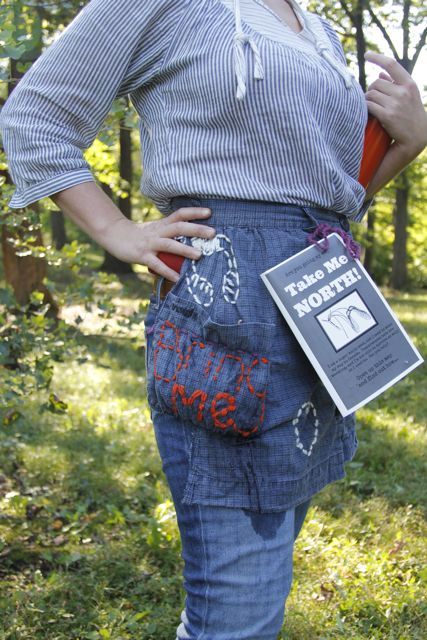Wearable Gardens
A Platform2 Participatory Performance, 2011
Arnold Arboretum, Boston, MA
Participants spread around the maple grove, picking out seeds that looked mature, dried, and worn. Around the seeds, participants packed dirt, moss, and leaves to protect them during the next 3-5 months, during which time they would travel north to where, as climate change continues to transform the temperatures and precipitation levels across the globe, the Sugar Maple will be more likely to survive.
Participants addressed the design challenge of making a wearable pocket that could travel on a human body, could keep the seeds moist and cool, and have some level of friction through its movement in order to keep the seeds alive. The creations varied: seed bearing scarves, an armpit band, a garter belt, a jacket sleeve and a pocket-on-a-stick. The items were decorated with embroidery, with lace, with yarn and with instructions. A map was attached to each Wearable Garden to aid in sending the seeds on their way north. The map included information on the various viable territories for the maple seed and how they may change between now and the year 2100, along with information on how to care for the seeds. It included 3 different highway routes up the East Coast, each ending in a different region in Canada projected to have the most conducive climate to Sugar Maples 100 years from now.

The wearable gardens could be transported by their creators, or left for others to pick up and bring on the next leg of the journey. Each participant had ideas in mind of where they would leave their gardens. One participant was on his way to Maine that very weekend and intended to leave it at a maple-sugaring shack. Another was headed to Vermont. Yet another had plans to visit a CSA farm, also in Maine, and planned to leave her creations there. Regardless of their destination, these gardens served both as earnest attempts to assist in this plant’s migration and potential for survival, as well as conversation instigators about the tangible changes to an iconic member of the New England landscape due to the human impact on the environment.
We cannot display this gallery

